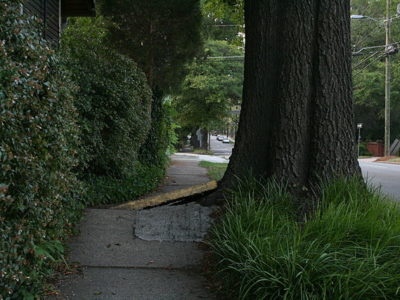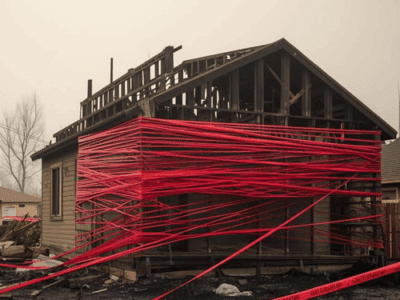Two Cheers For CEQA
A recent case shows why the law is so important – and how it can be abused

Even the best and conscientious developers gnash their teeth at CEQA, California’s environmental review law, and one can see why: it can allow NIMBYs to block useful housing and supercharge exclusion. But there’s a reason why the law was passed and why it has persisted, and we saw it three days ago:
Trees of Los Angeles can let out a deep breath of fresh oxygen after a recent court ruling halted the City of L.A.’s plan to chop down as many as 13,000 shade trees citywide, in the name of sidewalk repairs.
The Los Angeles Superior Court Mitchell Beckloff sided with tree advocates and declared the Environmental Impact Report for the city’s proposed repair program “fundamentally flawed” in late January.
The lawsuit was filed by advocates from Angelenos for Trees and United Neighborhoods for Los Angeles who were distressed by the plan to kill thousands of trees without considering alternative repair methods that would preserve trees.
“We saw that they were proposing to remove over 12,000 trees and we felt that that was excessive. Other cities manage their sidewalk tree conflict easily and for whatever reason L.A. does not,” said said Jeanne McConnell of Angelenos for Trees.
On its face, it seems absurd, and I was struck by the failure of any city official to defend massive tree removal on substantive grounds: that’s not the attorneys’ job, but shouldn’t someone argue that it’s a good idea?
The city was in something of a bind: its sidewalks are in such bad shape that disability rights advocates sued a couple of years ago. But the complete and utter lack of creativity and vision from City Hall here would be laughable if it were not so common.
And it shows the sort of pathetic silo management that has come to characterize Los Angeles: this city proudly sees itself as an environmental leader, and talks about planting One Million Trees — and now wants to cut down 13,000 mature ones?
Yes, settling the case is expensive. Perhaps this was the most cost-effective option. But perhaps not: city leaders are infamous for saying things must be done a particular way only to have such assertions crumble as fast as sidewalks under closer inspection. I follow local politics a lot, and as far as I could tell, there was virtually no public debate on any of this.
Well, for the time being, the trees are safe. And in no small part due to CEQA.
But embedded in the article shows the bad side of the law: In addition to the environmental benefits, advocates also say that there is an economic and racial justice imperative to save trees.
“In low-income communities, street trees play a more important role than they do in communities that have high canopy cover,” said [plaintiffs’ attorney Jamie] Hall. “If you look to South L.A. or other areas, you’ll see far less green and that’s because there’s more apartment complexes, there’s multi-family units, and also where there are single-family homes there’s not as many trees.”
If Hall actually believes that, he should get out more. The idea that apartment complexes are the cause of urban deforestation makes no sense. Many apartment buildings around the world cover themselves in greenery, and much of the loss of green cover on Los Angeles’ streets comes not from multifamily units, but from deforestation in single-family neighborhoods and lots. Multifamily units have nothing to do with it.
There is a genuine danger that NIMBYs will fight multifamily development using bad ideas like this — and CEQA will allow them to do it.

Something is deeply wrong with environmental policy in Los Angeles. Just last week, the City Council moved ahead with an unproven allegedly green hydrogen project that threatened localized impacts against low-income communities of color, while still acknowledging that they really don’t have a good sense of what the technology will permit. That means that the plant will still burn natural gas for the near future.
So why did they do it? I do not know, but I suspect that the powerful IBEW union at the Los Angeles Department of Water and Power had something to do with it. In other words, it wasn’t about green energy at all. It possibly would have been feasible to increase such experimentation to the city’s remaining coal-powered plant in rural Utah. But LA DWP workers probably don’t want to live there. I can hardly blame them, but I see little reason to experiment with low-income communities here. (I will leave the rest of this discussion for now to our resident hydrogen expert, Gabe Greif).
All of this seems to be on auto-pilot — precisely the sort of thing that CEQA was designed to protect against. New Mayor Karen Bass is still getting her administration together — she has significantly less transition time than previous mayors because of changes in the timing of elections and office turnovers. But the time to move is now.
Reader Comments
One Reply to “Two Cheers For CEQA”
Comments are closed.







I have no idea where the overall tree loss in LA has or hasn’t occured. (And the study only looked at SFH areas, it seems?)
I do think though that mature trees often get destroyed in any type of new building, including in-fill developments. So I think people remember their experience of seeing their local trees taken out, and perhaps they make mistaken assumptions based on it.
Meanwhile, if you want to ban teardown-McMansions and ADUs to protect trees, I would be perfectly fine with that. I would also love to see new development be confined to the upper levels of already existing buildings. I really don’t think we need to pave over every last inch here. (Save Angels Knoll!!! Somebody please.)
But what I *really* want to know is, where in LA do you ever see a real “public debate?” We know it’s not happening at the local paper.
No really – I’d like to know, please.